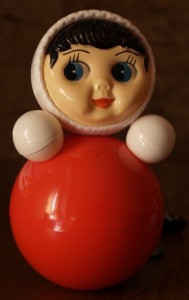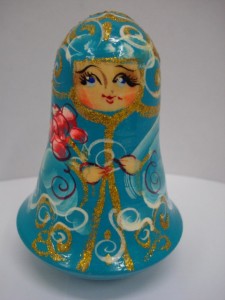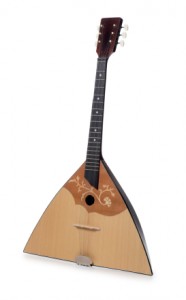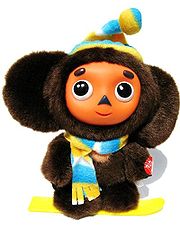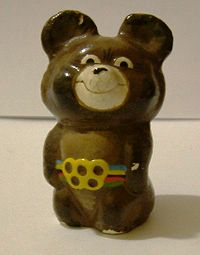The Soviet Space Programme: Sputnik to Mir – A Century of Russian Pride
Written by Vadim on February 10, 2009 – 3:25 pm - Some of the most popular Russian toys from the second half of the twentieth century were toys related to the Soviet space program. It’s no wonder that this unlikely topic captured the imagination of several generations of Russian tots. From the launch of Sputnik I in 1957, the space program was a proud symbol of the skill and supremacy of the Soviet Union.
Some of the most popular Russian toys from the second half of the twentieth century were toys related to the Soviet space program. It’s no wonder that this unlikely topic captured the imagination of several generations of Russian tots. From the launch of Sputnik I in 1957, the space program was a proud symbol of the skill and supremacy of the Soviet Union.
Sputnik opened not just an interest in space and astronomy, but a love of education and the sciences. Although the Soviet Union began as a movement of the working class, it found its renaissance in technology. The passion ignited by Sputnik was strong enough to sustain the country over a decades-long arms race. This enthusiasm was fed by the Cold War against the United States of America, which was romanticized as a competition between the opposing ideologies of communism and capitalism.
 For a while, it appeared that communism was winning the battle of the brains. The Soviet Union was not just the first nation to launch a satellite into space, but the first nation to put a man, then a woman, into space through the groundbreaking Vostok program.
For a while, it appeared that communism was winning the battle of the brains. The Soviet Union was not just the first nation to launch a satellite into space, but the first nation to put a man, then a woman, into space through the groundbreaking Vostok program.
Among the most popular Soviet space toys were toy rockets, made to resemble famous Soviet rockets such as the highly successful Proton rockets, which have been in continual use for several decades, and the R-7 rockets.
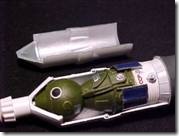 Another giant leap for mankind made by the Soviet Union was the Soyuz program, a manned space program which has put more humans into space than any other in history. In a nation fraught with economic and political troubles, these triumphs caught the imagination and spirit of millions of Russians. A generation of children grew up playing with scale Soyuz space capsules and envisioning themselves as the next pioneer to see the Earth from the outside in.
Another giant leap for mankind made by the Soviet Union was the Soyuz program, a manned space program which has put more humans into space than any other in history. In a nation fraught with economic and political troubles, these triumphs caught the imagination and spirit of millions of Russians. A generation of children grew up playing with scale Soyuz space capsules and envisioning themselves as the next pioneer to see the Earth from the outside in.
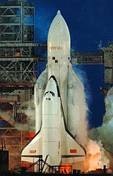 Like the American space shuttle it imitates, the Soviet Buran space shuttle was a recognizable symbol of the country’s advances into the unknown frontier of space. As the Cold War came to a close and Soviet-American relationships thawed, the space program continued to raise national pride and stimulate interest in the sciences.
Like the American space shuttle it imitates, the Soviet Buran space shuttle was a recognizable symbol of the country’s advances into the unknown frontier of space. As the Cold War came to a close and Soviet-American relationships thawed, the space program continued to raise national pride and stimulate interest in the sciences.
 The third generation of Soviet space craft culminated in the space station Mir, which was visited by astronauts from many different nations. Mir stayed in orbit for just days short of a decade, and outlasted the transition from a Soviet space program to a purely Russian one.
The third generation of Soviet space craft culminated in the space station Mir, which was visited by astronauts from many different nations. Mir stayed in orbit for just days short of a decade, and outlasted the transition from a Soviet space program to a purely Russian one.
 The Soviet space program has been an enduring point of Russian pride, and nowhere is this as evident as in Russian toys from this era. Models can be found of almost every declassified Soviet spacecraft. The toys range from the fanciful to perfectly scaled replicas. Although the Russian space program continues, it will never have the place in society it held during the Cold War. For just a few decades in time, travel in space was a symbol of hope and triumph in a nation that yearned for both. The era may be past, but its spirit lives on in the many toys and models that enthralled millions of Russian children.
The Soviet space program has been an enduring point of Russian pride, and nowhere is this as evident as in Russian toys from this era. Models can be found of almost every declassified Soviet spacecraft. The toys range from the fanciful to perfectly scaled replicas. Although the Russian space program continues, it will never have the place in society it held during the Cold War. For just a few decades in time, travel in space was a symbol of hope and triumph in a nation that yearned for both. The era may be past, but its spirit lives on in the many toys and models that enthralled millions of Russian children.
References:
http://en.wikipedia.org/wiki/Soviet_space_program
http://en.wikipedia.org/wiki/Sputnik
http://en.wikipedia.org/wiki/Vostok
http://en.wikipedia.org/wiki/Proton_(rocket)
http://en.wikipedia.org/wiki/Soyuz_spacecraft
http://en.wikipedia.org/wiki/Buran_(spacecraft)
http://en.wikipedia.org/wiki/Mir
Tags: rocket, soyuz, space capsule, space toys, sputnik
Posted in General | No Comments »
Russian Tumbler Toys Nevalyashka and Vanka Vstanka
Written by Vadim on November 22, 2008 – 12:00 pm -In Russia and many former Soviet countries, almost every child played with one of these toys when they were little – an upright doll with a round heavy base that stands on the floor. When you try and push the doll over, it springs back upright.
In Russian, they go by two names – ‘Nevalyashka’, meaning ‘One who never lies down’ and ‘Vanka Vstanka’ – a rhyming, alliterative phrase meaning ‘Ivan get up’. Vanka Vstanka is also the name of a contemporary Russian energy drink, similar to Red Bull.
In English, they are referred to as ‘Tilting Dolls’, ‘Bell Dolls’, ‘Tumbler Toys’ and ‘Roly Poly Toys’.
Nevalyashkas come in two popular varieties – one with an internal bell that rings when the doll shakes [as shown above] and other variety which is made of timber that can be painted [shown below].
It has been suggested by Elena Marus of the site WOW Russia, that the Nevalyashka/Vanka Vstanka is a dual-purpose toy that is intended to develop an infant’s hearing and sense of touch. She also states that it is purported to “develop creativity, imagination, hearing and movement co-ordination in children, but nobody knows exactly how it works”.
Here is a video showing the Nevalyashka doll in action:
Tags: dolls, nevalyashka, toys, tumbler, vanka vstanka
Posted in General | No Comments »
The Russian Guitar (Balalaika)
Written by Vadim on November 21, 2008 – 4:56 pm -The Balalaika or Balalayka is a truly authentic Russian musical instrument and a key part of traditional Russian music. It is often heard in Russian Restaurants and at cultural events.
It is instantly recognised by its distinctive three-cornered body. Most Balalaikas have three strings, but there are also six-stringed Balalaikas. It is often referred to as a ‘Russian Guitar’, although technically it shares more similarities with the Mandolin or Banjo.
The three-stringed Balalaika is traditionally tuned to the notes E-E-A (the two lower strings have the same pitch).
The Balalaika was popular as a village instrument for centuries, particularly with the Skomorokhs – a group of people who could be best described as free-lance musical comedy performers. Their tunes often ridiculed the Tsar, the Russian Orthodox Church, and Russian society in general. For this reason, bans were imposed from time to time on the playing of Balalaika music. The first written reference to a Balalaika was on an arrest slip for two serfs in 1688, accused of being drunk and disorderly outside the Kremlin in Moscow, playing the Balalaika.
No-one is completely sure how the Balalaika got its distinctive triangular shape, but there are multiple theories to explain it:
One popular notion is that the three sides and strings of the Balalaika are supposed to represent the Holy Trinity. This explanation is not considered credible, due to the fact that musical instruments are not allowed in Russian Orthodox liturgy, and due to the church’s contempt towards the Skomorokhs.
A likelier reason is given by the writer and historian Nikolai Gogol in his unfinished novel Dead Souls (1842). He states that a Balalaika was made by peasants out of a pumpkin. If you quarter a pumpkin, you are left with a Balalaika shape.
A third theory is that just before the rule of Tsar Peter The Great (1682-1725), there had been a ban on all musical instruments. When Peter re-allowed them, only the boat builders knew how to work with wood. The Balalaika looks a little like the front of a boat, if held horizontally.
The final theory comes from a Russian tale. During the Mongol invasion of Rus (a historic slavic region that includes parts of Ukraine, Russia, Belarus, Poland and Slovakia), a Russian man from Nizhny Novgorod was captured by the Mongols, but the Mongol Khan [ruler] liked him because of his musical talent, so he released him and gave him a guitar. When the Russian man returned home, he removed three strings from the guitar, so that he would be able to repair it if he broke one of the strings, so he was left with a 3-string guitar.
Here is a video of the skilled Balalaika duo Alex Siniavski and Mikhail Smirnov, who are seen here bringing out the best sound from this instrument:
References (In Russian):
- A 1983 article by Dmitry Belinskiy from the newspaper Krymskaya Pravda
- History of Balalaika, by Georgy Nefyodov
Tags: balalaika, guitar, musical intrument
Posted in General | No Comments »
The Story of Cheburashka
Written by Vadim on November 17, 2008 – 8:50 pm -Cheburashka is a famous character in Russian children’s literature. He was first introduced in 1965, in a story named “Gena the Crocodile and His Friends”, created by the Russian writer Eduard Uspensky.
According to the story, Cheburashka is a funny little animal, unknown to science, with an appearance that can be characterized as being somewhere between that of a monkey and a bear. He lives in the tropical forest. Cheburashka’s name means “one, who tumbles down”. He is described as “feeling lonely” and “searching for identity”.
Cheburashka has appeared in several books and animated series:
- 1969 – Gena the Crocodile and His Friends
- 1971 – Cheburashka
- 1974 – Old Lady Shapoklyak
- 1983 – Cheburashka Goes to School
He was used as the mascot of the Russian Olympic team in the 2004 Summer Olympics in Greece and a white-coloured Cheburashka was used in the 2006 Winter Olympic Games in Turin, Italy.
Cheburashka may have inspired the development of the Japanese ‘Pokemon’ [Pocket Monsters] phenomenon decades later in the 1990s. Indeed, Cheburashka has developed a loyal following in Japan following the screening of an animated film series between 2001 and 2002.
Collectibles are widely sold in Russia, former Soviet Republics and Japan.
Here is video from the Soviet animated TV series, subtitled in English:
Tags: cheburashka, dolls, toys
Posted in General | No Comments »
Misha the Bear – the Mascot of the 1980 Moscow Oympics
Written by Vadim on November 17, 2008 – 8:27 pm -The 1980 Moscow Olympics took place during the peak of the Cold War. Following the Soviet Union’s invasion of Afghanistan, most of the Western hemisphere chose to boycott the games. 80 Nations competed all up – 1/3 less than in the Munich Olympics in 1972
The games however did produce two lasting legacies – the unofficial theme song “Moscow” by the German disco band Dschinghis Khan, and the official Olympic mascot “Misha”, the bear cub (also known as “Mischka”).
In Russian, ‘Misha’ and ‘Mischka’ are the diminutive forms of the Russian male name ‘Mikhail’, the equivalent of ‘Michael’ in English. The bear is also an animal that traditionally used to symbolise Russia and the Soviet Union, much like the Bald Eagle is used in the USA.
Misha was designed by Victor Chizhnikov – a renowned Russian Children’s book illustrator. In 1977, the committee organizing the Olympics held a contest for the best illustration of a bear. The judges chose Victor Chizhikov’s design depicting a smiling bear cub wearing a blue-black-yellow-green-red (colors of the Olympic rings) belt, with a golden buckle shaped like the five rings. Misha was confirmed as an official mascot on December 19th, 1977.
Misha is the first mascot of a sporting event to achieve large-scale commercial success as merchandise. The Misha doll was used extensively during the opening and closing ceremonies, had a TV animated cartoon and appeared on several merchandise products. Misha also appeared in the 1980 Olympics episode of the Russian cartoon Nu, pogodi!, handing trophies to the Wolf and the Hare.
Due to the success of Misha, sporting mascots have assumed a prominent role in all Olympic Games following 1980 and have even been introduced into other sporting competitions like the FIFA world cup.
Here is a video excerpt from the 1980 Moscow Olympics closing ceremony showing a large inflatable Misha Bear being released into the sky. The music playing is “Goodbye, Moscow”, created by Nikolai Dobronravov and Aleksandra Pakhmutova.
References:
http://en.wikipedia.org/wiki/Misha
http://olympic-museum.de/mascot/mascot1980.htm
Russian site dedicated to the Moscow Olympics
Translation of closing ceremony song “Goodbye, Moscow” into English
Tags: misha, moscow olympics, olympic games, toys
Posted in General | No Comments »
